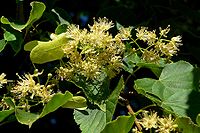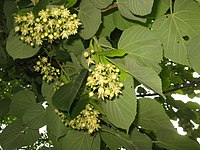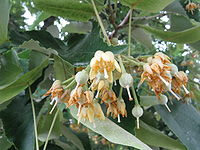Tilia
| Tilia Temporal range:
| |
|---|---|

| |
| Tilia tomentosa, cultivated at the Morton Arboretum near Chicago | |
| Scientific classification | |
| Kingdom: | Plantae |
| Clade: | Tracheophytes |
| Clade: | Angiosperms |
| Clade: | Eudicots |
| Clade: | Rosids |
| Order: | Malvales |
| Family: | Malvaceae |
| Subfamily: | Tilioideae |
| Genus: | Tilia L. |
| Species | |
|
About 30 | |
Tilia is a
Tilia species are mostly large,
Tilia is the only known ectomycorrhizal genus in the family Malvaceae. Studies of ectomycorrhizal relations of Tilia species indicate a wide range of fungal symbionts and a preference toward Ascomycota fungal partners.[3][4][5]
Name
The genus is generally called "lime" or "linden" in Britain[6] and "linden", "lime", or "basswood" in North America.[2]
"Lime" is an altered form of
"Linden" was originally the adjective, "made from linwood or lime-wood" (equivalent to "wooden" or "oaken"); from the late 16th century, "linden" was also used as a noun, probably influenced by translations of German romance, as an adoption of Linden, the plural of Linde in Dutch[7] and German.[citation needed] Neither the name nor the tree is related to Citrus genus species and hybrids that go by the same name, such as Key limes (Citrus × aurantifolia). Another common name used in North America is basswood, derived from bast, the name for the inner bark (see Uses, below). Teil is an old name for the lime tree.
In Chinese, "椴/duàn" or "椴樹/duànshù" is a general term for Tilia species.
Description


The Tilia's sturdy trunk stands like a pillar and the branches divide and subdivide into numerous ramifications on which the twigs are fine and thick. In summer, these are profusely clothed with large leaves and the result is a dense head of abundant foliage.[9]
The leaves of all the Tilia species are heart-shaped, and most are asymmetrical. The tiny, pea-like fruit hangs attached to a ribbon-like, greenish-yellow bract whose apparent purpose is to launch the ripened seed clusters just a little beyond the parent tree. The flowers of the European and American Tilia species are similar, except the American ones bear a petal-like scale among their stamens and the European varieties are devoid of these appendages. All of the Tilia species may be propagated by cuttings and grafting, as well as by seed. They grow rapidly in rich soil, but are subject to the attack of many insects. Tilia is notoriously difficult to propagate from seed unless collected fresh in fall. If allowed to dry, the seeds go into a deep dormancy and take 18 months to germinate.[9]
In particular, aphids are attracted by the rich supply of sap, and are in turn often "farmed" by ants for the production of the sap, which the ants collect for their own use, and the result can often be a dripping of excess sap onto the lower branches and leaves, and anything else below. Cars left under the trees can quickly become coated with a film of the syrup ("honeydew") thus dropped from higher up. The ant/aphid "farming" process does not appear to cause any serious damage to the trees.
-
Leaf of common lime (Tilia × europaea) showing venation
-
Tilia flowers
-
Tilia fruit
-
The venation within a Tilia bract
History
In Europe, some linden trees reached considerable ages. A
- The excellence of the honey of the far-famed Hyblaean Mountains[13] was due to the linden trees that covered its sides and crowned its summit.
- Lime fossils have been found in the Tertiary formations of Grinnell Land, Canada, at 82°N latitude, and in Svalbard, Norway. Sapporta believed he had found there the common ancestor of the Tilia species of Europe and America.[9]
Uses
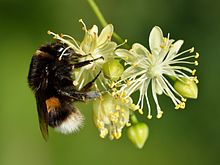
The linden is recommended as an ornamental tree when a mass of foliage or a deep shade is desired.
In
Wood

Linden trees produce soft and easily worked timber, which has very little grain and a density of 560 kg/m3.[17] It was often used by Germanic tribes for constructing shields. It is a popular wood for model building and for intricate carving. Especially in Germany, it was the classic wood for sculpture from the Middle Ages onwards and is the material for the elaborate altarpieces of Veit Stoss, Tilman Riemenschneider, and many others. In England, it was the favoured medium of the sculptor Grinling Gibbons[18] (1648–1721). The wood is used in marionette- and puppet-making and -carving. Having a fine, light grain and being comparatively light in weight, it has been used for centuries for this purpose; despite the availability of modern alternatives, it remains one of the main materials used as of 2015[update]. In China, it was also widely used in carving or furniture, interior decorating, handicrafts, etc.[14]
Ease of working and good acoustic properties also make limewood popular for electric and bass guitar bodies and for
Linden wood is also the material of choice for window blinds and shutters. Real-wood blinds are often made from this lightweight but strong and stable wood, which is well suited to natural and stained finishes.[citation needed]
In China, 冻蘑/"dongmo" grows well on decomposing logs of Tilia trees in the old-growth forest;[14] therefore, people use logs of Tilia trees to cultivate S. edulis and even Black fungus or shiitake mushrooms with excellent results. Currently, "椴木黑木耳/Tilia-logs-black fungus" or "椴木香菇/Tilia-logs-shiitake mushrooms" has become a term for a method of cultivating black fungus and shiitake mushrooms and "椴木/Tilia-logs" no longer exclusively refers to Tilia tree wood but also to other woods suitable for black fungus or shiitake mushrooms cultivation.[19]
In Russian, "linden-made" (липовый, lipoviy) is a term for forgery, due to the popularity of the material for making forged seals in the past centuries.[20]
Bark
Known in the trade as basswood, particularly in North America, its name originates from the inner fibrous bark of the tree, known as bast. A strong
Nectar
Tilia is a high-quality wild honey plant. In China, "椴树蜜/Tilia honey" is produced in the northeast region. White in color, it is called "white honey" or "snow honey". Heilongjiang is well-known throughout the country for producing high-quality "Tilia honey": Heilongjiang not only has lush Tilia trees, but also a rare and excellent bee species - "东北黑蜂/Northeast Black Bee" to collect honey(Raohe County is the location of the national "东北黑蜂自然保护区/Northeast Black Bee Nature Reserve". It is the only nature reserve for bees in Asia.[24]).[25] "Tilia honey" mainly comes from Tilia amurensis and Tilia mandshurica.[25] "Tilia honey" and southern "longan honey" and "lychee honey" are called "China's three famous honeys".[14] "Tilia honey", "rape honey" and "black acacia honey" are the three most productive honeys in China.[26]
Phytochemicals
The dried flowers are mildly sweet and sticky, and the fruit is somewhat sweet and mucilaginous. Linden flower tea has a pleasing taste, due to the aromatic
The nectar contains a major secondary metabolite with the trivial name tiliaside (1-[4-(1-hydroxy-1-methylethyl)-1,3-cyclohexadiene-1-carboxylate]-6-O-β-D-glucopyranosyl-β-D-glucopyranose) which is transformed in the gut of bumblebees to the aglycone (i.e., the gentiobiose group is cleaved) which is bioactive against a common and debilitating gut parasite of bumblebees, Crithidia bombi. This naturally occurring compound may support bees to manage the burden of disease - one of the major contributors to pollinator decline.[28]
Other uses
A beverage made from dried linden leaves and flowers is brewed and consumed as a folk medicine and relaxant in many Balkan countries, including Serbia and Greece.[29] Usually, the double-flowered species are used to make perfumes.[citation needed] The leaf buds and young leaves are also edible raw.[30][31]
Tilia species are used as food plants by the larvae of some Lepidoptera; see List of Lepidoptera that feed on Tilia.
Classification




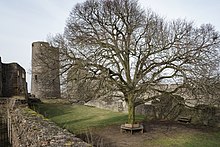
This list comprises the most widely accepted species, hybrids, and cultivars".
Species
- Tilia americana L. – American basswood, American linden
- Tilia amurensis – Amur lime, Amur linden
- Tilia caroliniana – Carolina basswood
- Tilia chinensis – Chinese linden
- W.C.Cheng
- Tilia cordata Mill. – Small-leaved lime, little-leaf linden or greenspire linden
- Tilia dasystyla Steven
- Szyszyl.– Henry's lime, Henry's linden
- Tilia hupehensis – Hubei lime
- Tilia insularis
- Tilia intonsa
- Tilia japonica – Japanese lime, shina (when used as a laminate)
- †Tilia johnsoni Wolfe & Wehr Eocene; Washington and British Columbia
- Tilia kiusiana
- Tilia mandshurica – Manchurian lime
- Tilia maximowicziana
- Tilia miqueliana
- Tilia mongolica Maxim. – Mongolian lime, Mongolian linden
- Tilia nasczokinii – Nasczokin's lime, Nasczokin's linden
- Tilia nobilis – noble lime
- Tilia officinarum
- Tilia oliveri – Oliver's lime
- Tilia paucicostata
- Tilia platyphyllos Scop. – large-leaved lime
- Tilia rubra – Red stem lime (syn. T. platyphyllos var. rubra)
- Tilia tomentosa Moench – silver lime, silver linden
- Szyszyl.
Hybrids and cultivars
- Tilia × euchlora (T. dasystyla × T. cordata)
- Tilia × europaea – Common lime (T. cordata × T. platyphyllos; syn. T. × vulgaris)
- Tilia × petiolaris (T. tomentosa × T. ?)
- Tilia 'Flavescens' – Glenleven linden (T. americana × T. cordata)
- Tilia 'Moltkei' (T. americana × T. petiolaris)
- Tilia 'Orbicularis' (hybrid, unknown origin)
- Tilia 'Spectabilis' (hybrid, unknown origin)
Gallery
-
Tilia heterophylla(syn. T. monticola)
See also
- Germany's armisticewith the United States
- Lime tree in culture
- Matryoshka doll, made from linden trees
- St Lawrence Lime, a former lime tree in Canterbury, England
- Tanzlinde (Effeltrich)
References
- ^ USDA, NRCS (n.d.). "Tilia". The PLANTS Database (plants.usda.gov). Greensboro, North Carolina: National Plant Data Team. Retrieved 10 December 2015.
- ^ a b "Linden, definition". Merriam Webster dictionary. Retrieved May 25, 2020.
- .
- S2CID 91789869.
- S2CID 244182315.
- ^ Brown, Lesley (ed.). 2002. Shorter Oxford English Dictionary, vol. 1, A–M. 5th ed. Oxford: Oxford University Press, p. 1600.
- ^ a b "Linde". Van Dale (in Dutch). Retrieved 2023-04-08.
- ^ "Vergeten woorden – L". Taaldacht (in Dutch). 2015-08-21. Retrieved 2023-04-08.
- ^ a b c d e Keeler, Harriet L. (1900). Our Native Trees and How to Identify Them. New York: Charles Scribner's Sons. pp. 24–31.
- ^ Podlewska, Katrina (March 4, 2013). "Celebrating Westonbirt's 2000 Year Old Lime". Friends of Westonbirt Arboretum. Retrieved May 25, 2020.
- ^ Šmid Hribar, Mateja. "Najevska lipa" [Najevnik Linden Tree]. In Šmid Hribar, Mateja; Golež, Gregor; Podjed, Dan; Kladnik, Drago; Erhartič, Bojan; Pavlin, Primož; Ines, Jerele (eds.). Enciklopedija naravne in kulturne dediščine na Slovenskem – DEDI [Encyclopedia of Natural and Cultural Heritage in Slovenia] (in Slovenian). Retrieved 28 August 2013.
- ^ 苏怡. "英華殿" (in Chinese). The Palace Museum. Retrieved 2023-01-12.
- ^ "Honey". Encyclopædia Britannica (9th ed.). Retrieved November 22, 2011.
...honey most esteemed by the ancients was that of Mount Hybla in Sicily...
- ^ a b c d 刘玉波 (2020-12-21). "椴树:名蜜之源 与佛结缘" (in Chinese). www.forestry.gov.cn. Retrieved 2023-01-11.
- ^ "Gaddesden lime avenue". www.chilternsaonb.org. Chilterns Conservation Board. Retrieved 22 December 2021.
- S2CID 190901271. Retrieved 22 December 2021.
- ^ "Lime timber". Niche Timbers. Archived from the original on 21 May 2011. Retrieved 19 August 2009.
- ^ "Hampton Court Palace: Grinling Gibbons". Hrp.org.uk. Retrieved July 6, 2012.
- ^ "椴木黑木耳和黑木耳的区别,椴木栽培黑木耳技术" (in Chinese). 农业种植网. 2019-06-15. Retrieved 2023-01-17.
- ^ "За что обидели липу?". January 2011. Archived from the original on 2014-10-25. Retrieved 2013-11-07.
- ^ Kallio, Edwin; Richard M. Godman (1973). American Basswood... an American Wood. US Forest Service. p. 5.
- PMID 27418485.
- ^ 关云德 (2010-04-30). "东北满族人的树皮蓑衣" (in Chinese). www.chinanews.com.cn. Retrieved 2023-01-11.
- ^ "饶河地域文化之四:东北黑蜂" (in Chinese). /www.raohe.gov.cn. Retrieved 2023-01-11.
- ^ a b "独特的东北黑蜂和椴树蜜" (in Chinese). new.qq.com. Retrieved 2023-01-11.
- ^ 乔江涛. "研究发现油菜蜜、洋槐蜜和椴树蜜中标志性成分" (in Chinese). Institute of Apicultural Research, CAAS. Retrieved 2023-01-11.
- ^ Bradley P., ed. (1992). British Herbal Compendium. Vol. 1: 142–144. British Herbal Medicine Association, Dorset (Great Britain)
- PMID 35491601.)
{{cite journal}}: CS1 maint: multiple names: authors list (link - ISSN 0926-6690.
- ^ "Tilia cordata Small Leaved Lime, Littleleaf linden". PFAF Plant Database.
- ^ "Tilia americana American Basswood, Carolina basswood, Basswood, AmericanBasswood, American Linden". PFAF Plant Database.
Bibliography
- ISBN 9780521840545.
External links
- Eichhorn, Markus (January 2012). "Lime Trees and Bees". Test Tube. Brady Haran for the University of Nottingham.









